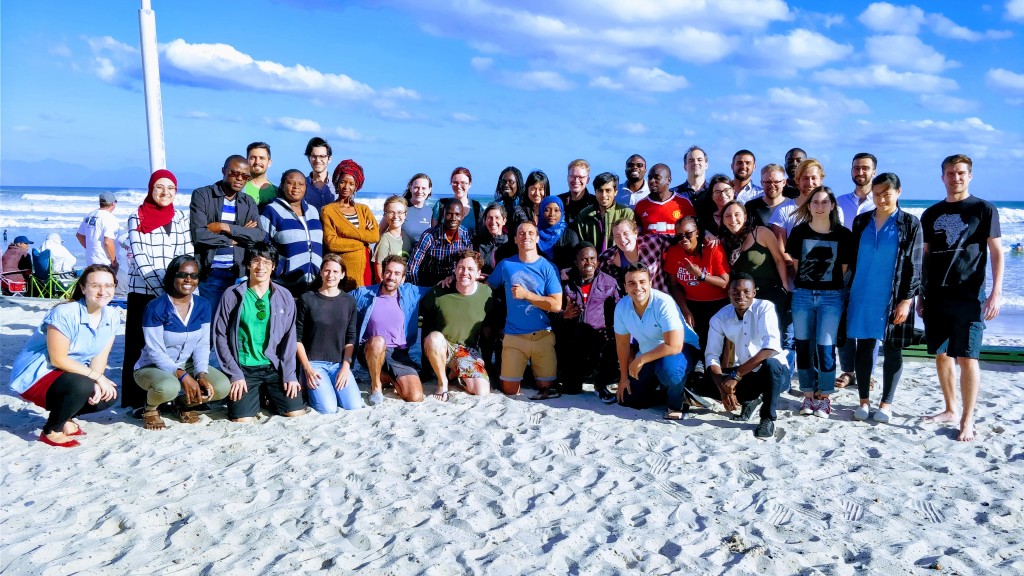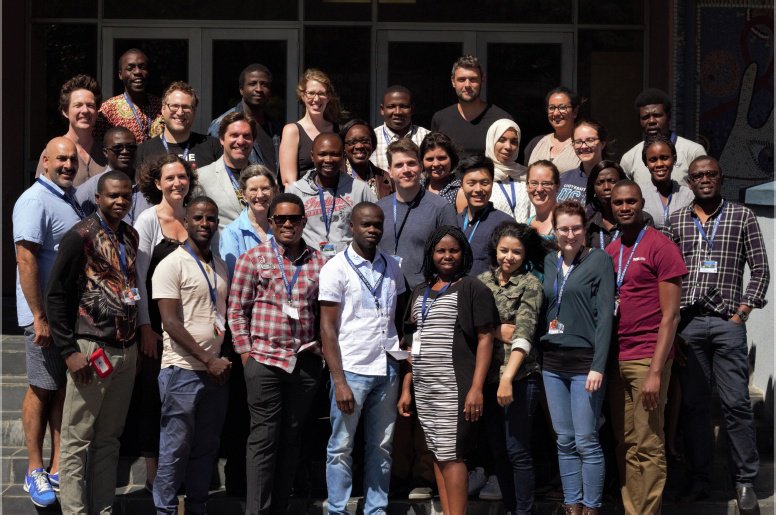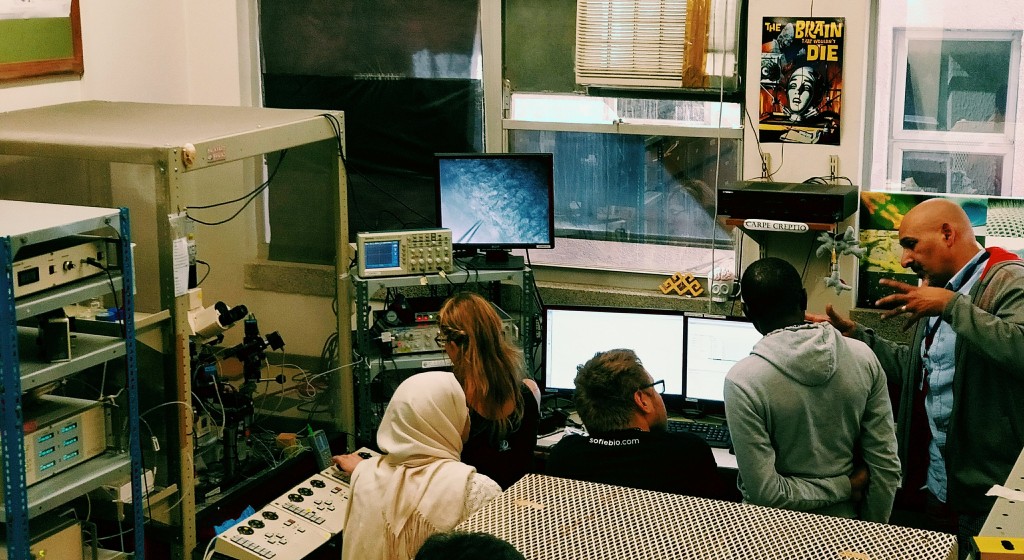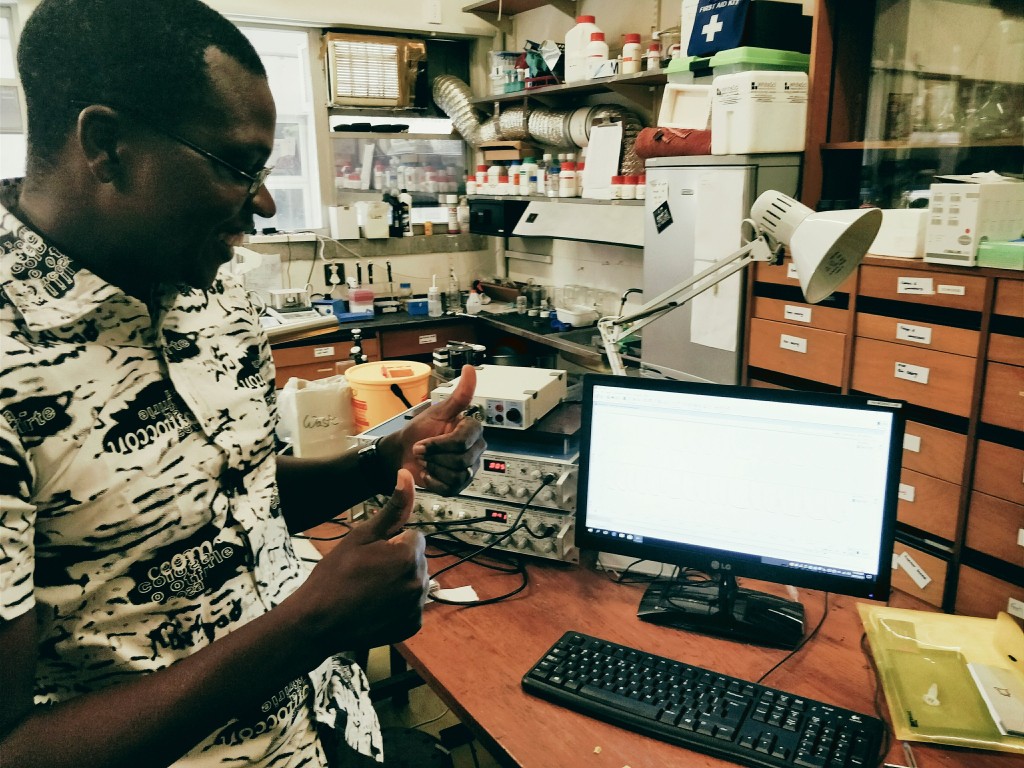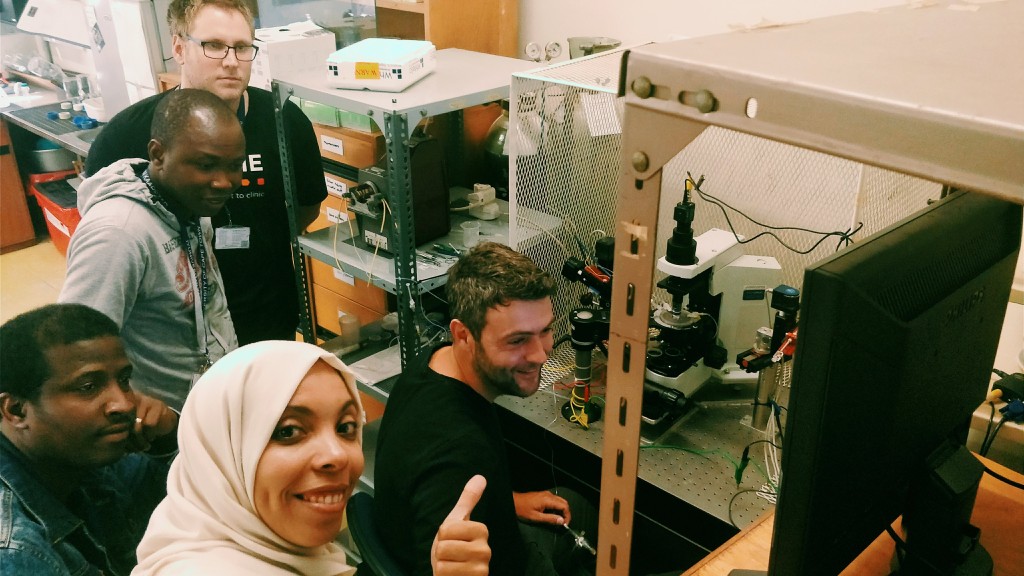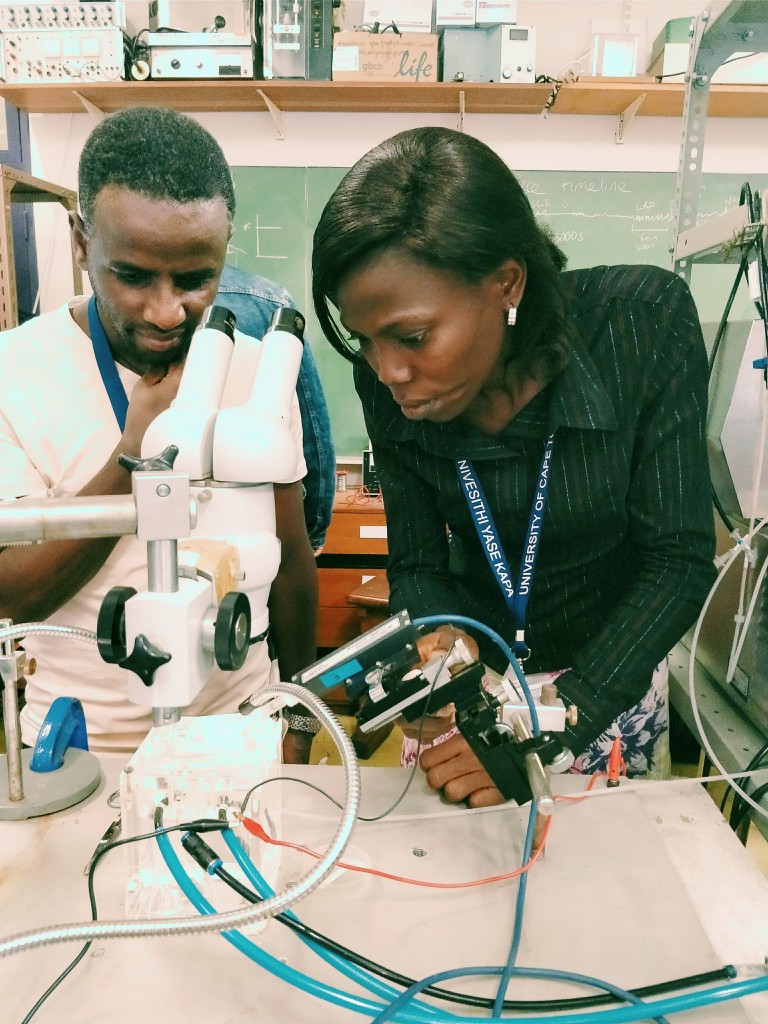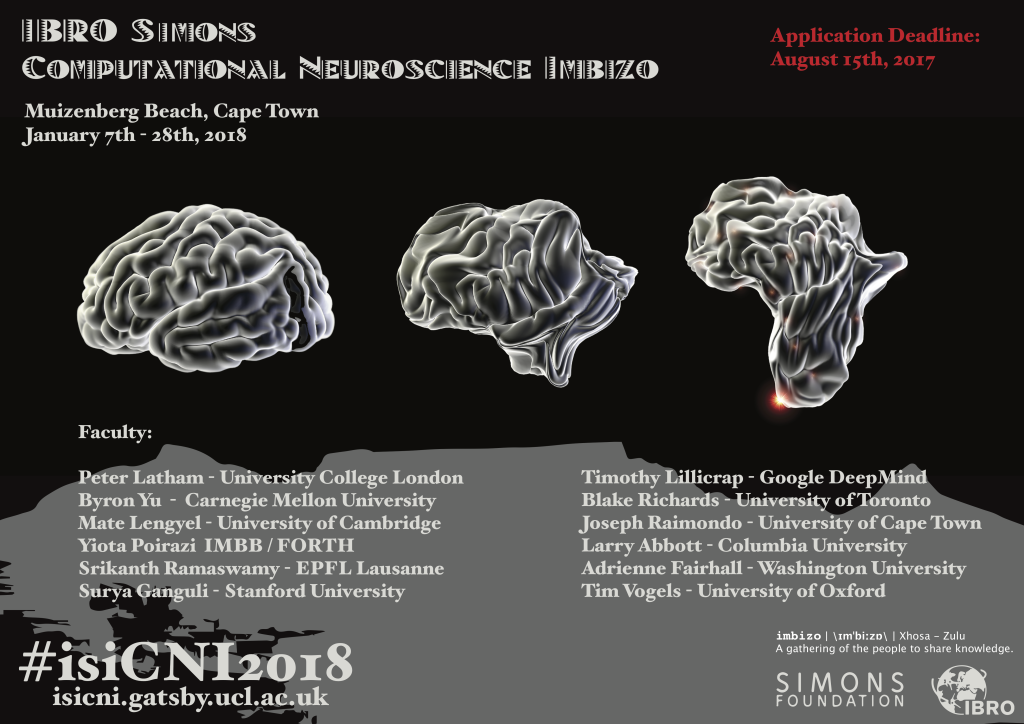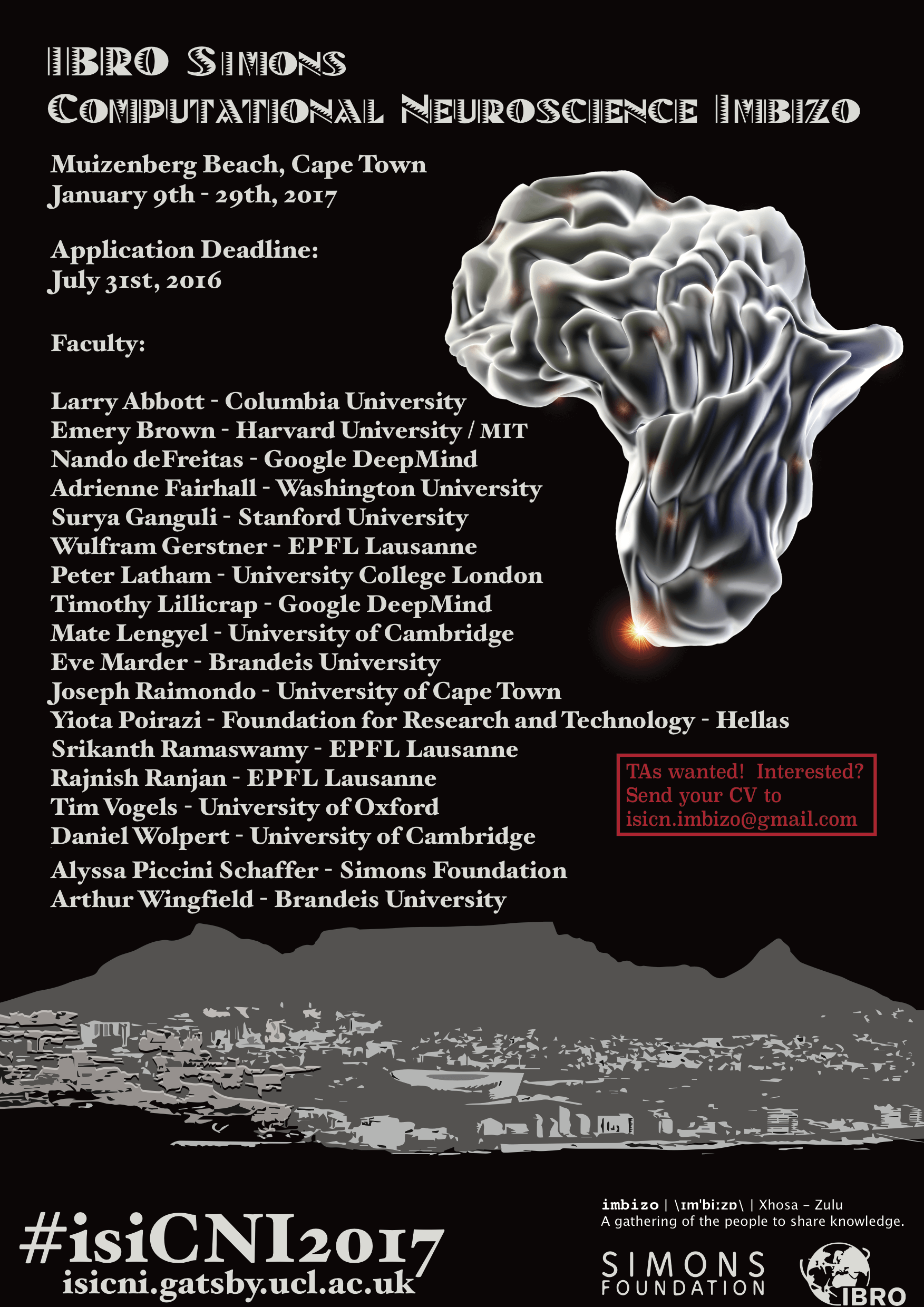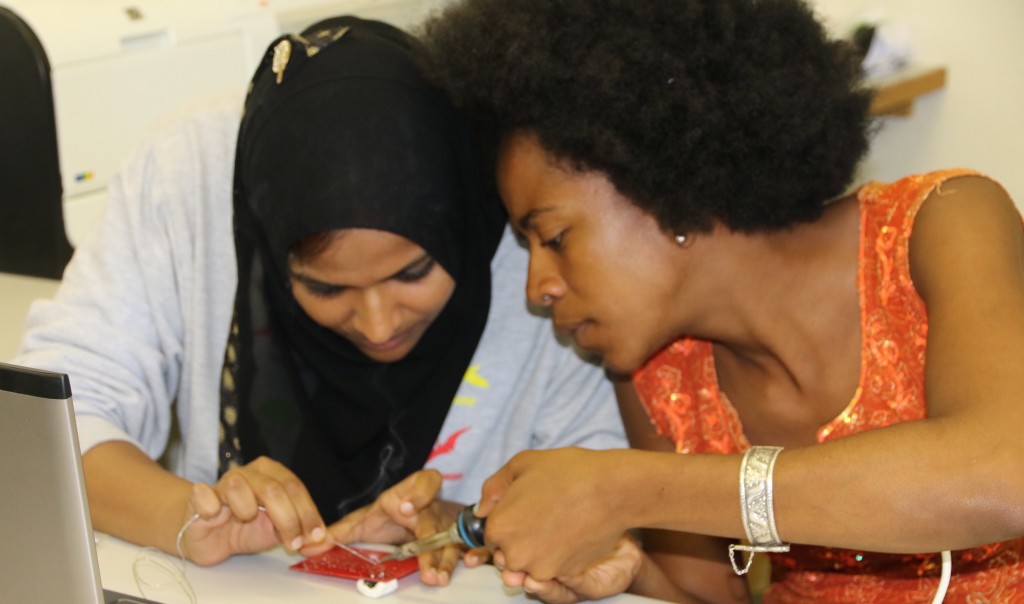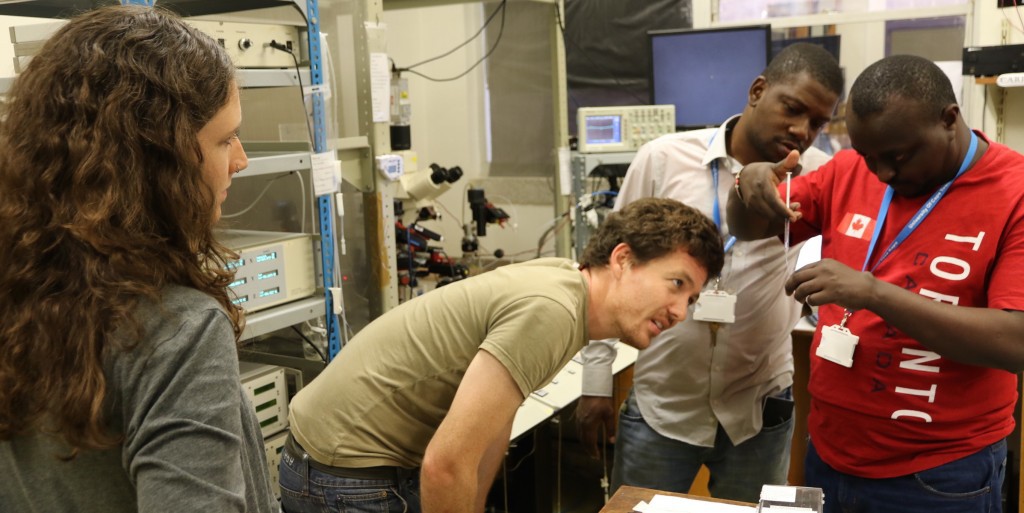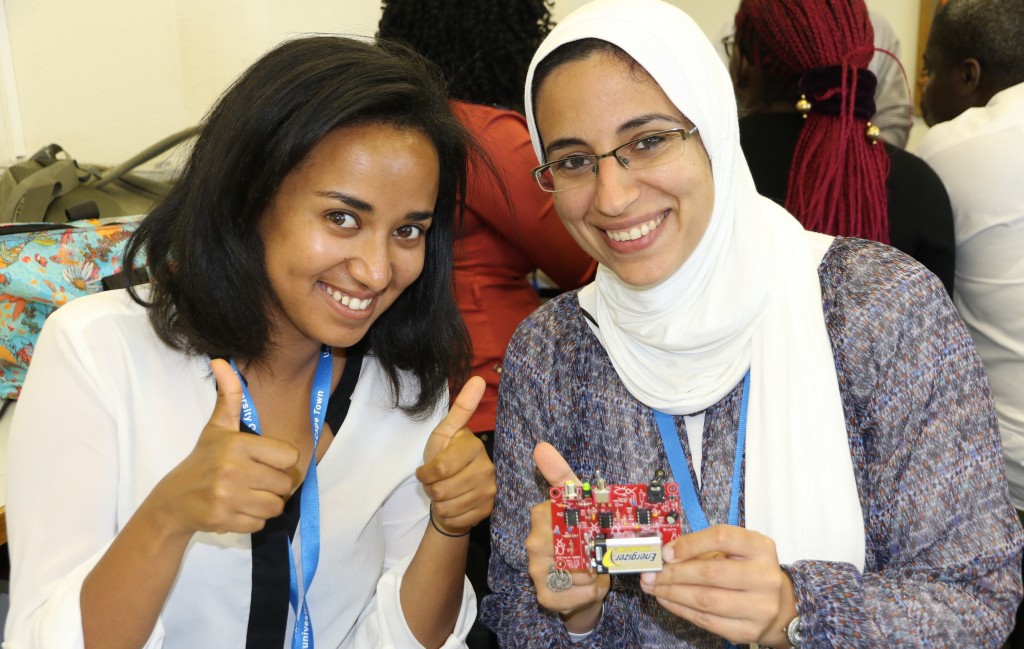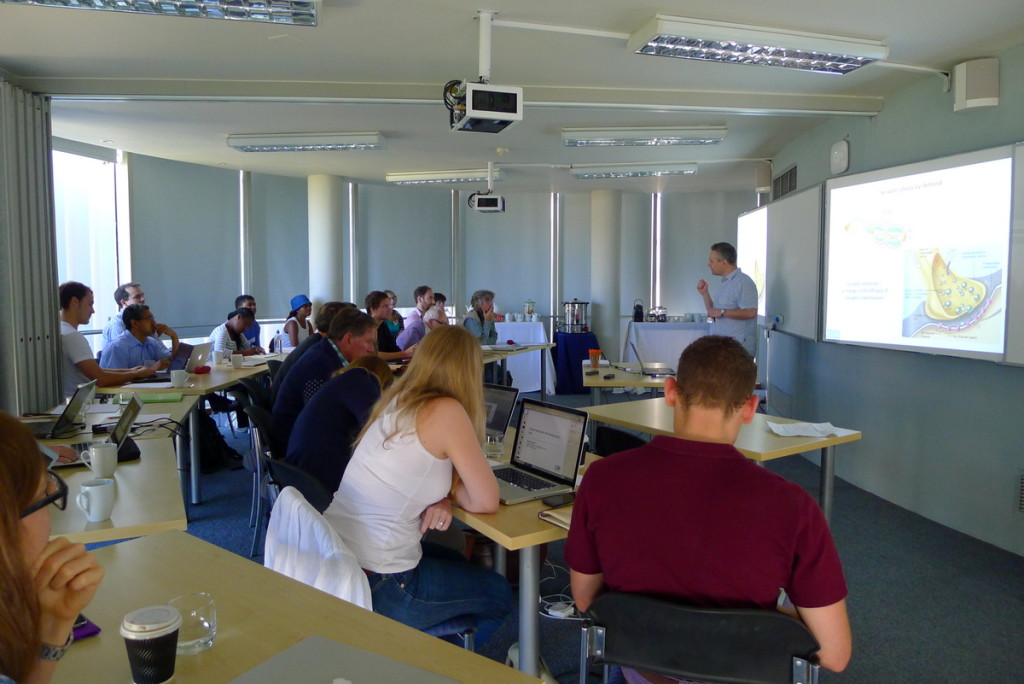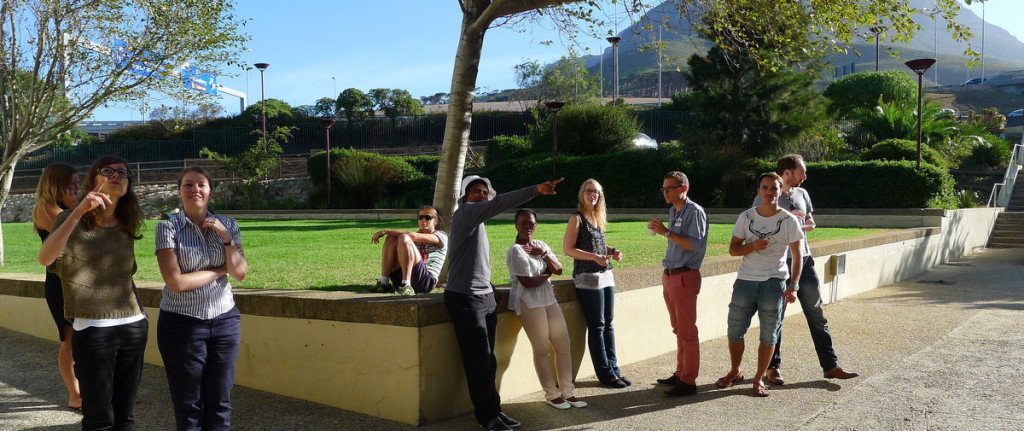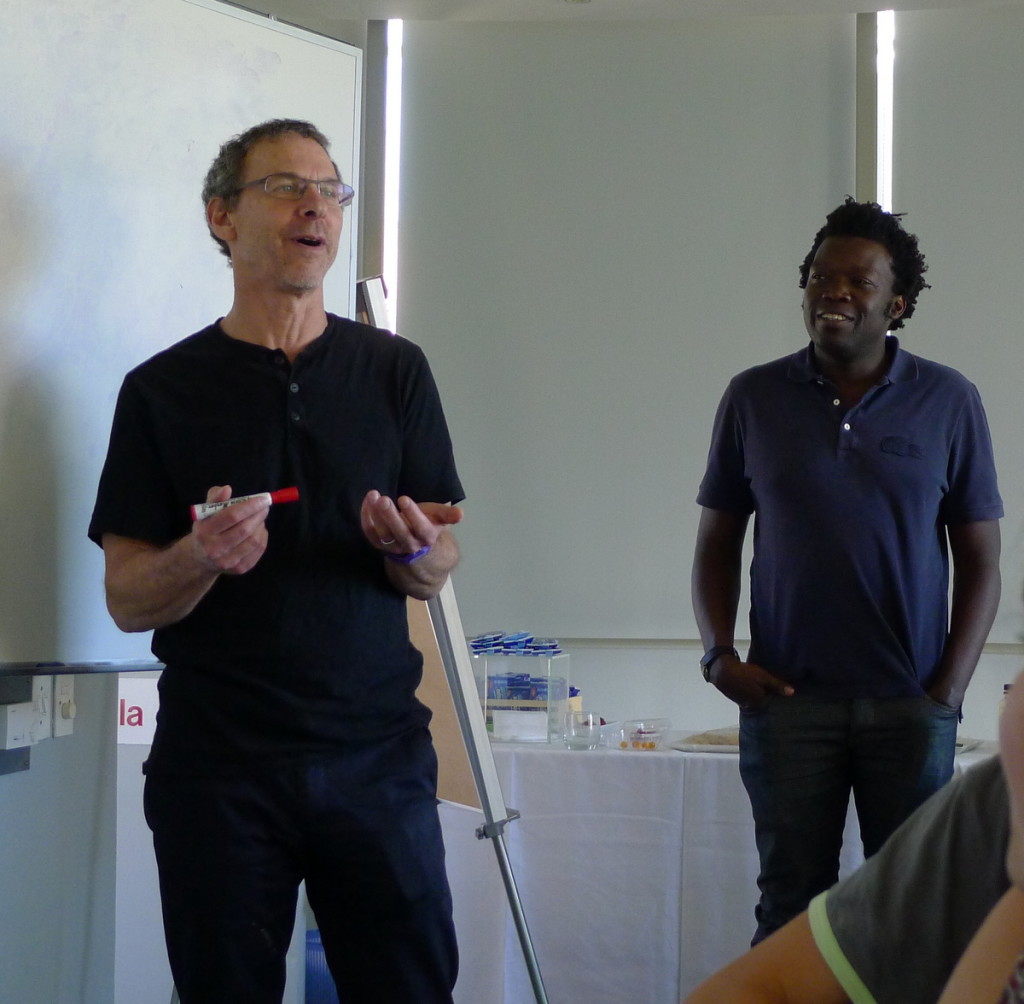Here is our lovely glossy report on the Imbizo from 2017-2019: Imbizo_report
Category Archives: Schools and Conferences
isiCNI2019 is underway!
The third iteration of the IBRO-SIMONS Computational Neuroscience Imbizo – isiCNI2019 is currently underway in Muizenberg! Read more about it here: http://imbizo.africa/ or follow us Twitter
The goal of this 3 week summer school is to build computational neuroscience capacity in Africa by bringing together African and International students under the tutelage of world-leading experts in the field.
IBRO-UCT African Advanced School on Techniques in Neuroscience – Dec 2017
 In December 2017 the lab helped organise and run the IBRO-UCT African Advanced School on Techniques in Neuroscience. The school was also supported by the Newton Fund. Many of the techniques established in the lab: whole-cell patch-clamp, interface local field potential recordings and Ca2+ imaging featured as part of the school. The full school report can be found here.
In December 2017 the lab helped organise and run the IBRO-UCT African Advanced School on Techniques in Neuroscience. The school was also supported by the Newton Fund. Many of the techniques established in the lab: whole-cell patch-clamp, interface local field potential recordings and Ca2+ imaging featured as part of the school. The full school report can be found here.
isiCNI2018
After the smashing success of isiCNI2017 – the IBRO-SIMONS Computational Neuroscience Imbizo – is back for round 2 in January 2018. Please find more details at http://isicni.gatsby.ucl.ac.uk/. The application deadline is 15th August 2017.
isiCNI2017
Together with Tim Vogels, Peter Latham and Alex Antrobus we are organised a computational neuroscience school held in Muizenberg in January 2017. The goal of the school was to build computational neuroscience capacity in Africa by bringing together African and International students under the tutelage of world-leading experts in the field. We managed to attract some all star faculty for the first iteration of isiCNI.
If you are interested in what the school was like please see our report below:
IBRO-UCT African Advanced School on Epilepsy 2015
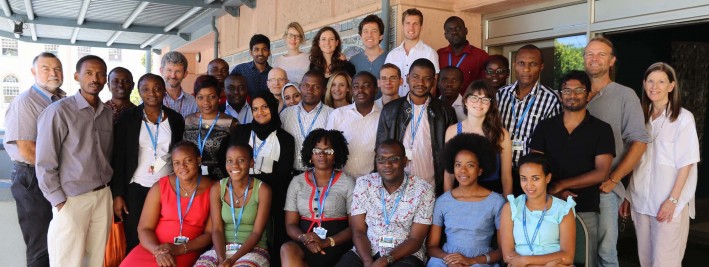 In December 2015 we helped host the IBRO-UCT African Advanced School on Epilepsy. This was the first school hosted by the new IBRO Centre for Advanced Neuroscience Schools at the University of Cape Town. The Raimondo Lab was responsible for organising and hosting the basic neuroscience component of the school.
In December 2015 we helped host the IBRO-UCT African Advanced School on Epilepsy. This was the first school hosted by the new IBRO Centre for Advanced Neuroscience Schools at the University of Cape Town. The Raimondo Lab was responsible for organising and hosting the basic neuroscience component of the school.
The first day of the basic neuroscience component included introductory lectures to the principles of neurophysiology which established the conceptual grounding for much of the advanced material presented in the remainder of the course. Topics included the basis of membrane potential, action potentials, the intrinsic properties of neurons and neurotransmission. This was followed by a hands on workshop where students were taught the NEURON simulation environment. This allowed them consolidate the material learnt earlier in the day and also be introduced to the premier technology and programming environment for creating neural simulations. Each student generated their own complex morphological simulation of a single neuron. The day was ended with some entertainment by one of South Africa’s premier slight of hand artists and illusionists – Stuart Lightbody.
On the second day students received a lecture on advanced brain imaging, which was followed by a practical session where they prepared brain slices for immunohistochemistry. In the afternoon, students were introduced to electronics and soldering. In groups of 2 they spent the afternoon building their own bioamplifiers (Backyard Brains Spikerboxes). This was a challenging task as electronics was unfamiliar to many of the students. This was an empowering exercise however as after 3 hours of burnt fingers and many destroyed components we had atleast 7 working amplifiers!
The following day students received a world-class introduction to advanced topics in the basic neuroscience of epilepsy delivered by Andrew Trevelyan of Newcastle University. They continued their immunohistochemistry practical by staining their brain slices. The afternoon was spent using the amplifiers built the previous day to record action potentials from the cockroach leg preparation. Students learned the concepts and techniques necessary to make extracellular recordings from neurons. Students worked in groups of two, where they had access to their own amplifier, laptop computer recording station. They used this experiment to explore rate coding in sensory systems. As a fun addition, students performed microstimulation of their cockroach legs using pop music.
The following three days saw students receiving two lectures in the morning followed by a daily rotation through one of three advanced practical sessions. The lecture topics included the anatomy of brain circuitry, models of seizure activity, network mechanisms in seizures, infectious causes of epilepsy, drosophila in the laboratory and ion dynamics in seizures. The practical sessions included hands on experience: 1) patch-clamping single neurons and making intracellular recordings during epileptiform activity. 2) performing interface chamber experiments to record field potentials during in vitro seizures. 3) performing confocal imaging of the immunohistochemistry tissue prepared during earlier days of the school.
The students engaged well especially since many of the techniques and concepts were unfamiliar. Although it is unlikely that students would have become experts in any of the techniques learned during the school (the duration was too short for this) they now know what is possible and how these techniques can be asked to answer important questions in epilepsy research.
UK-SA Royal Society NRF Neuroscience Seminar March 2015
In March 2015 together with Tim Vogels from the CNCB at Oxford University we hosted a 3 day multi-disciplinary neuroscience seminar at the University of Cape Town entitled: Neural Network Dynamics in Health and Disease.
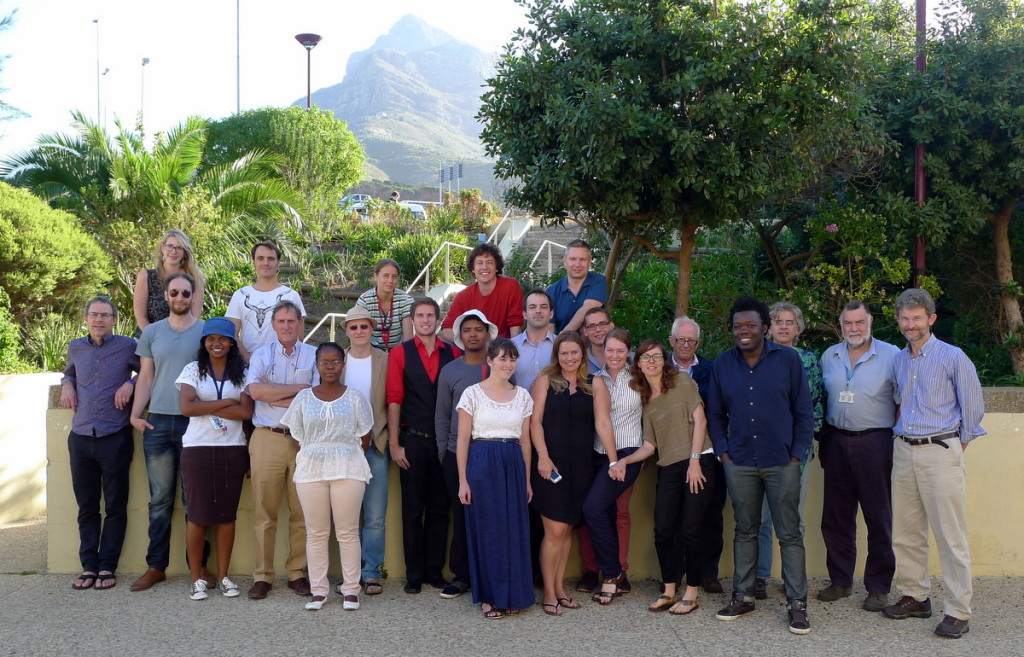
Participants of the UK-SA Royal Society NRF Neuroscience Seminar. From left to right: Peter Latham, Hayley Tomes, Jonathan Shock, Phuti Choshi, Alex Antrobus, Robert Millar, Khanyisile Kgoadi, Andy Trevelyan, Lizelle Niit, Chris Currin, Buchule Mbobo, Joseph Raimondo, Kira Dusterwald, Tim Vogels, Janine Scholefield, Colin Akerman, Richard Burman, Robyn Brackin, Anca Savulescu, George Ellis, Musa Mhlanga, Henri Laurie, Laurie Kellaway, Graham Fieggen
The main objective of the meeting was to bring together a series of neuroscientists from the UK and South Africa that are all interested in understanding neural network dynamics, but approach the problem from different levels of analysis – from a cellular, a synaptic or a computational perspective. We sought to encourage discussions that could span multiple modes of analysis. We aimed to provide a space which would help forge collaborative links between neuroscientists in the United Kingdom and their counterparts in South Africa. Lastly, we aimed to raise the profile of neuroscience in South Africa and the UK by increasing the capacity to perform research of both local and global relevance.
Example feedback from the meeting:
“I thought the meeting was a triumph – the talks were, almost without exception excellent, but the real triumph was the idea to mix up such a range of real expertise. This created a really interesting dynamic in the speaker-audience interaction, with no question being “too stupid”. It forced people to build up their topic up from first principles. This is an excellent approach to doing neuroscientific, or indeed any kind of research, in my view. I was very impressed at the diversity of the audience, and the quality of discussion was really high, and yet always respectful and pursued simply from a desire to clarify matters. Given the complementary set of skills that the different participants brought to the table, I hope and expect that the meeting will kindle various collaborative ventures.” – Dr Andrew Trevelyan
“Thanks for organizing an amazing symposium. I was impressed with the intellectual breadth and depth of the people at uct. It made me really excited about moving there. It was fun to interact with everyone and I enjoyed my conversations with Peter, Tim and others. Very impressive!” – Dr Musa Mhlanga
“The meeting was very useful in terms of brining together a variety of views on the brain and its relation to genetics. The high level talks highlighted important issues in a very useful way.” – Prof George Ellis
The programme:
